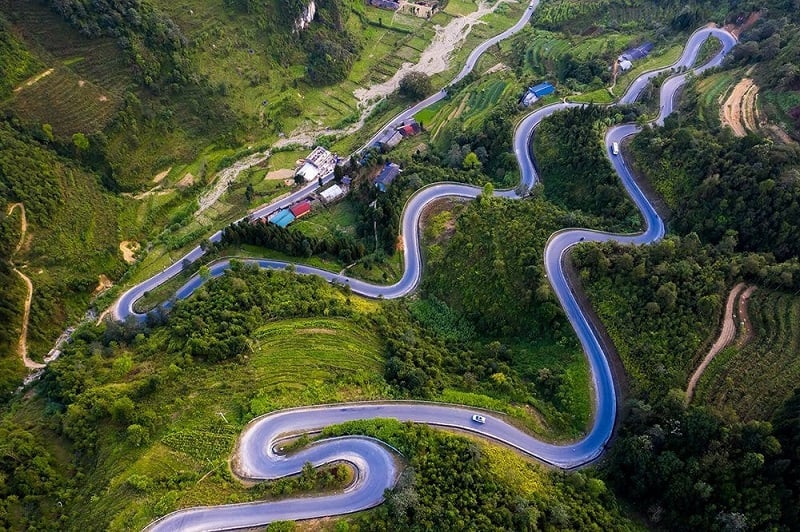Alright, fellow wanderlusters! Your seasoned travel expert, who’s logged more miles than a well-worn motorbike on a Ha Giang Loop adventure, is here to deliver the ultimate deep dive into one of Vietnam’s most iconic and soul-stirring destinations. If you’re looking to truly understand the magic, the grit, and the sheer audacity of nature and human spirit that defines this incredible region, then you’ve landed in the right place.
Today, we’re focusing on the crown jewel of the Ha Giang Loop: the legendary Ma Pi Leng Pass and the epic saga of its creation, the Happiness Road. This isn’t just a road trip; it’s a journey into the heart of an enduring legacy. So, buckle up, whether you’re eyeing a thrilling Ha Giang motorbike tour or the comfortable majesty of a Ha Giang Jeep tour, because this story is for you.
Let’s start with the basics. The Ha Giang Loop isn’t just a route; it’s a rite of passage for adventurers. Nestled in Vietnam’s northernmost province, this loop traces a path through the Dong Van Karst Plateau Geopark, a UNESCO-recognized wonderland of jagged limestone mountains, emerald valleys, and vibrant ethnic cultures. It’s a place where every turn in the road reveals a postcard-perfect vista, and every village offers a glimpse into a way of life deeply connected to the land.
For years, the Ha Giang Loop has been synonymous with motorbike tours. The thrill of the open road, the wind in your hair, and the direct connection to the landscapes are undeniable. Many travelers opt for a self-guided Ha Giang motorbike tour, armed with a rented bike and a sense of daring. Others prefer the “easy rider” option, where a local driver navigates the challenging terrain while you soak in the views from the back of the bike.
But for those who crave comfort, safety, or simply want to focus on the spectacular scenery without the demands of driving, the Jeep tour Ha Giang experience has become an increasingly popular and fantastic alternative. Imagine cruising in a rugged open-air vehicle, your expert local driver handling the twists and turns, leaving you free to truly absorb the majesty of the mountains. A Jeep tour allows you to bring more luggage, offers a more stable ride (especially appealing if you’re traveling with family or have mobility concerns), and often comes with the added benefit of a dedicated guide who can provide invaluable insights into the local culture and history. We’ll delve deeper into choosing your adventure style later on!
Regardless of how you tackle it, the Ha Giang Loop promises an unforgettable journey. But amongst its many wonders, one stands out, an undeniable masterpiece of nature and human endeavor: the Ma Pi Leng Pass.
Ma Pi Leng Pass: The King of All Passes
If you’ve seen photos of Ha Giang, chances are you’ve seen the Ma Pi Leng Pass. It’s the iconic image, the one that makes your jaw drop and your heart pound. Stretching approximately 20 kilometers along National Highway 4C, connecting the towns of Dong Van and Meo Vac, Ma Pi Leng is often hailed as one of Vietnam’s “Four Great Mountain Passes” – and for good reason.
Its name, “Ma Pi Leng,” in the H’Mong language, roughly translates to “horse’s nose bridge,” or more evocatively, “the horse’s bridge where even the horse has to stop to breathe.” This vividly paints a picture of its extreme steepness and daunting challenge even for the most sure-footed animals. When you stand on the precipice, gazing down into the abyss, you understand exactly what they meant.

A Symphony of Scale and Beauty
From the various viewpoints along the pass, the panorama is simply breathtaking. On one side, colossal, razor-sharp limestone karsts rise dramatically, their ancient forms sculpted by millennia of wind and rain. On the other, a dizzying drop plunges hundreds of meters into the emerald ribbon of the Nho Que River, winding its way through the deepest canyon in Southeast Asia, the Tu San Gorge.
The sheer scale of the landscape is humbling. Clouds often drift just below your feet, creating an ethereal, otherworldly atmosphere. Sunrises and sunsets here are legendary, painting the sky in fiery hues that reflect off the jagged peaks, a photographer’s dream.
But Ma Pi Leng is more than just a pretty face. It’s a place steeped in human drama, a testament to an incredible feat of engineering and sacrifice that paved the way for modern life in this remote highland region. And that brings us to the astonishing story of the Happiness Road.
The Happiness Road: Carved by Hand, Paved with Dreams
To understand the true significance of Ma Pi Leng Pass, you must understand the Happiness Road (Đường Hạnh Phúc). This 185-kilometer stretch of road, traversing Ha Giang City through Quan Ba, Yen Minh, Dong Van, and Meo Vac, is far more than just asphalt and gravel. It is a symbol of human resilience, sacrifice, and an unwavering pursuit of progress against unimaginable odds.
A Land Isolated: Before the Road
Before the Happiness Road, the four highland districts of Ha Giang – Dong Van, Meo Vac, Yen Minh, and Quan Ba – were virtually cut off from the rest of Vietnam. Traveling between villages, let alone to Ha Giang City or Hanoi, was an arduous, multi-day trek over treacherous mountain paths. Life was incredibly harsh. Education, healthcare, and economic opportunities were scarce. The H’Mong, Dao, Tay, and other ethnic minority groups lived in isolation, their lives dictated by the unforgiving terrain.
Imagine a time when the only way to transport goods was on the backs of horses or humans, navigating paths so precarious that a single misstep could mean disaster. The people of Ha Giang longed for connection, for a lifeline that would bring them out of isolation and into a brighter future.
The Impossible Dream: Building a Road Through Hell
In the late 1950s and early 1960s, the Vietnamese government embarked on an ambitious project: to build a road that would connect these remote communities. It was a project that many considered impossible. The terrain was brutal – sheer cliffs, deep gorges, and solid rock mountains. Modern machinery was non-existent.
The construction of the Happiness Road began in 1959 and lasted an astonishing six years, finally completing in 1965. And here’s where the story becomes truly inspiring: it was built almost entirely by hand.
Over 1,300 young volunteers, predominantly ethnic minorities from the surrounding provinces, along with support from other regions of Vietnam, dedicated their lives to this monumental task. They worked with rudimentary tools: hammers, chisels, crowbars, and baskets. They blasted through mountainsides with explosives carried on their backs. They hung from ropes, chiseling away at vertical cliffs, inch by agonizing inch.
Ma Pi Leng: The “Death Peak”
The most challenging section, and the one that took the longest to complete, was the stretch through Ma Pi Leng Pass. This particular section earned the grim nickname “the Death Peak” due to the extreme danger and the countless lives risked and lost during its construction. For 11 months, 1,200 of the most skilled and courageous workers focused solely on carving a path through Ma Pi Leng. They literally chiseled the road out of the sheer rock face, often working suspended hundreds of meters above the Nho Que River.
Local folklore tells harrowing tales of workers living for months in makeshift camps on the mountainside, enduring freezing cold, scorching heat, and the constant threat of rockfalls. Many sacrificed their youth, their health, and even their lives, all for the dream of connection. The bravery and determination of these “human ants,” as they were sometimes called, are almost beyond comprehension.
When the final section of the Happiness Road was completed on March 20, 1965, it was a moment of profound triumph. The road was not just a means of transport; it was a symbol of unity, sacrifice, and the unwavering spirit of a nation. It was christened “Happiness Road” by none other than President Ho Chi Minh himself, a name that perfectly encapsulated the joy and opportunity it brought to the isolated communities.
What the Happiness Road Brought: A New Era for Ha Giang
The completion of the Happiness Road irrevocably transformed Ha Giang.
- Economic Development: Suddenly, goods could be transported more easily to and from the highlands. Farmers could bring their produce to market, and essential supplies could reach remote villages. This opened up new economic opportunities and slowly began to lift communities out of poverty.
- Access to Services: Healthcare, education, and government services became more accessible. Children could attend schools that were once too far to reach. People could receive medical attention that was previously unavailable.
- Cultural Exchange: The road broke down barriers, fostering greater interaction and understanding between different ethnic groups within Ha Giang and with people from other parts of Vietnam.
- Tourism: Today, the Happiness Road, particularly the Ma Pi Leng Pass, is the backbone of the Ha Giang Loop, drawing in countless international and domestic travelers. This tourism influx brings vital income to local communities, creating jobs and preserving unique cultural traditions.
Experiencing Ma Pi Leng and the Happiness Road Today
So, how can you truly experience this monumental feat of engineering and natural wonder? Whether you choose a Ha Giang motorbike tour or a comfortable Ha Giang Jeep tour, here’s what you can expect:
Motorbike Tour: The Rider’s Dream
For many, a Ha Giang motorbike tour is the quintessential way to experience the loop.
- Freedom and Connection: You’re in direct control, feeling every curve of the road, every change in elevation. It’s an intimate connection with the landscape.
- Challenges: The roads are winding, steep, and can be unpredictable (especially during rainy season). Previous motorbike experience is highly recommended. You’ll need to be comfortable with manual or semi-automatic bikes and navigating sometimes uneven terrain.
- Self-Guided vs. Easy Rider: You can rent a bike and go solo (ensure you have the correct international driving permit!). However, for safety and a deeper cultural immersion, many travelers opt for an easy rider tour. A local driver takes the handlebars, allowing you to relax, take photos, and engage with the stunning surroundings without the stress of navigating. This is a fantastic option for those without extensive riding experience or who simply want to maximize their enjoyment of the views.
Jeep Tour: Comfort, Safety, and Unrestricted Views
The Jeep tour Ha Giang option is growing rapidly in popularity for excellent reasons.
- Unparalleled Comfort: Forget aching backs and windburn! You’re in a spacious, often open-air vehicle, enjoying comfortable seating and protection from the elements. This is ideal for families, groups, or anyone who prefers a more relaxed pace.
- Safety First: Local drivers are incredibly experienced with Ha Giang’s roads. They know every twist, turn, and potential hazard, ensuring a secure and smooth journey. This is a major advantage on challenging sections like Ma Pi Leng.
- Focus on the Scenery: Without the need to concentrate on driving, you’re free to fully immerse yourself in the breathtaking panoramas. Your camera will thank you!
- Accessibility: Jeep tours make the Ha Giang Loop accessible to a wider range of travelers, including those with limited mobility or who are simply not comfortable on a motorbike.
- Guided Insights: Many Ha Giang Jeep tour packages include a knowledgeable local guide who can share fascinating stories, historical facts, and cultural insights, enriching your journey far beyond just seeing the sights. This is crucial for understanding the true depth of places like the Happiness Road.

Essential Stops and Experiences on Ma Pi Leng
- Ma Pi Leng Viewpoints: There are several designated viewpoints along the pass offering mind-blowing vistas. Take your time, soak it in, and capture those epic photos.
- Nho Que River Boat Trip: Don’t miss the opportunity to descend into the Tu San Gorge and take a boat trip on the emerald waters of the Nho Que River. Seeing Ma Pi Leng from below gives you an entirely new perspective on its colossal scale. Many Ha Giang Loop tour packages, especially Jeep tour Ha Giang options, include this as a highlight.
- Ma Pi Leng Skywalk (or “Death Road”): For the truly adventurous, there’s a narrow, often unpaved path clinging to the side of the cliff, offering even more dramatic views. While exhilarating, it requires extreme caution and is best attempted on foot or with a very experienced local guide. Always prioritize safety!
- Local Villages: As you traverse the Happiness Road, you’ll pass through charming H’Mong and Dao villages. Stop, interact with locals, perhaps enjoy a cup of traditional corn wine, and experience their hospitality. These interactions are invaluable for understanding the human stories behind the majestic landscapes.
Planning Your Ha Giang Loop Adventure
Ready to embark on your own Ha Giang Loop journey? Here are a few tips to make your trip unforgettable:
- Best Time to Visit: The dry season (October to April) generally offers the most stable weather, with clear skies perfect for photography. However, temperatures can be cool in winter. The wet season (May to September) brings lush green landscapes, but also increased chances of rain and slippery roads. Buckwheat flower season (October-November) and plum/peach blossom season (February-March) are particularly picturesque.
- How to Get There: Most travelers start their Ha Giang Loop adventure from Ha Giang City. You can reach Ha Giang City from Hanoi by overnight sleeper bus (recommended for comfort) or by private car. Many Ha Giang Loop tour operators offer convenient transfer services.
- Choosing Your Tour:
- Ha Giang Loop Tour Packages: For international travelers, booking a comprehensive package is often the easiest and most stress-free option. These packages typically include transportation from Hanoi, accommodation (often in local homestays for an authentic experience), meals, a guide, and your choice of transport (motorbike or Jeep).
- Jeep Tour Ha Giang: If you prioritize comfort, safety, and a more immersive sightseeing experience without the worries of driving, a Jeep tour is an excellent choice. Our jeep tour Ha Giang packages are designed to maximize your enjoyment and minimize any logistical headaches.
- Motorbike Tours: If you’re an experienced rider seeking the ultimate self-propelled adventure, a Ha Giang motorbike tour offers unparalleled freedom. Ensure your license is valid and consider hiring a local easy rider.
- What to Pack: Layers are key! Temperatures can vary dramatically. Bring warm clothing (especially for evenings and early mornings on the pass), a waterproof jacket, sturdy walking shoes, sunscreen, insect repellent, and a good camera.
- Respect Local Culture: Ha Giang is home to many ethnic minority groups. Be respectful of their customs, ask for permission before taking photos, and learn a few basic Vietnamese phrases.
- Safety First: Roads can be challenging. Drive cautiously if on a motorbike. If you’re on a Jeep tour, you’ll have an expert driver. Always wear a helmet if on a motorbike.
Final Thoughts: Why Ha Giang Will Capture Your Heart
The Ha Giang Loop, and particularly the awe-inspiring Ma Pi Leng Pass and its genesis, the Happiness Road, are more than just geographical wonders. They are powerful narratives of human endeavor, resilience, and the relentless pursuit of a better life. Every panoramic view, every winding curve, every local face you meet along this incredible journey tells a story.
This isn’t just a place to visit; it’s a place to feel. To feel the grandeur of nature, the indomitable spirit of humanity, and the profound sense of connection that comes from traversing a road carved by hand and paved with dreams.
Whether you choose the raw thrill of a Ha Giang motorbike tour or the comfortable majesty of a Ha Giang Jeep tour, prepare to be moved, inspired, and utterly captivated. The Ha Giang Loop is waiting to etch itself into your memory, a testament to the fact that true happiness can indeed be found, even on the steepest, most challenging roads.



